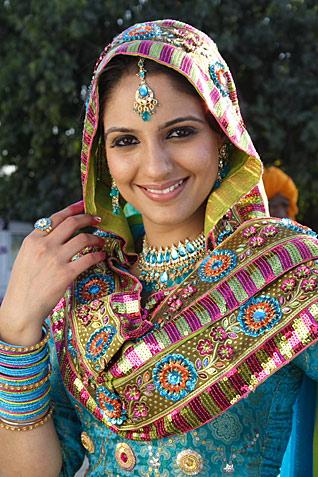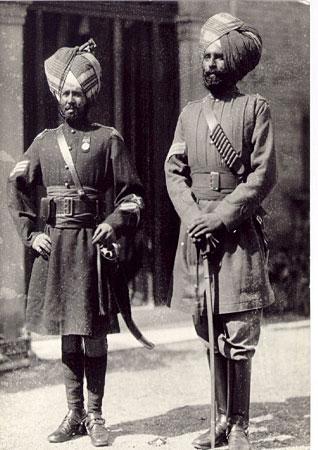Columnists
The Sikhs : Their Religion, Social Customs, and Way of Life
A Book Review by MANJYOT KAUR
THE SIKHS: THEIR RELIGION, SOCIAL CUSTOMS, AND WAY OF LIFE, by Jasbir Singh Khurana. Angus & Grapher, New Delhi, 2008. ISBN 81-9024-942-8. 340 pages. Price: US $125, Rs. 3,450.
The Sikhs: Their Religion, Social Customs, and Way of Life is the first book of a projected trilogy. The Sikhs: A Historical Perspective and The Sikhs: Their Historic Gurdwaras and Shrines are planned to appear as future installments of the series.
After a distinguished military career in the Indian Army, its author, Col. Jasbir Singh Khurana (Retd.), joined the management of Hindustan Lever Ltd (Unilever). A prolific writer, he has penned forty newspaper and journal articles dealing with India and travel, as well as a previous book, Khuranas of the Salt Range, published in 2004.
Khurana's stated target audience for his trilogy of "basic information in a readable and presentable format" is "Generation Next," especially those young Sikhs residing in the diaspora to whom he aims to impart information about the basic concepts, beliefs and customs of Sikhi, so they might gain a greater understanding of their roots and religious heritage.
This first volume of the proposed trilogy covers the three topics stated in its title with a multiple focus that includes the lives and teachings of the ten Sikh Gurus; what Khurana terms the "Sikh orders"; the religion's philosophy, theology and way of life; important aspects of the faith such as the role and status of women, religious and domestic ceremonies, and festivals; and "emerging trends and the need for reform."
A Foreword by Marshal of the Indian Air Force, Arjan Singh, and a Preface by the author introduce the work.
Some missteps are apparent in the book's first main section, aptly entitled "The Background," which discusses the Guru period of Sikh history. (Subsequent timeframes are scheduled to be covered in the next two books of the trilogy.)
At the start of this section, after calling Sikhi "the youngest of the religions practiced in India" and "one of the most vibrant faiths," the author states: "Its theology is almost Vedantic but the Khalsa tradition founded by Guru Gobind Singh in 1699 created a parallel Sikh identity and hence a bonding among them."
Shortly afterwards, he goes on to declare that "Nanak founded the Sikh faith on a synthesis of Hinduism and Islam" and that Sikhi "had to be acceptable to both Hindus and Muslims." Although he subsequently adds such phrases as "The Sikh religion was formed as an antithesis of irrational customs and rituals," and calls Sikhs "a distinct religious community," among other appellations, this introductory statement does not go as far as it could have in firmly situating Sikhi as a unique faith.
Further on in this key chapter, when mentioning that the Sikh "social order had to embrace all people without discrimination of class or caste," Khurana says, "However, the caste system continued to count in matrimonial alliances, even though it was abolished in social intercourse."
He even cites the Gurus themselves as examples of this ("Neither the Gurus nor any member of their families married outside their Kshatriya caste. Nanak was a Bedi, Angad a Trehan, Amar Das a Bhalla and the remaining seven were Sodhis belonging to one family."), without any words of further clarification, such as the fact that the first four Gurus were born into Hindu families, and therefore, intra-caste marriage would have been an expected part of their youthful lives.
An unequivocal statement that caste considerations are totally anathema to fundamental Gurmat principles is also lacking.
Another gaffe occurs at the end of Chapter I, when, during a comparison of Sikhi ("the youngest of the modern religions") with Judaism ("the oldest"), the author states, without additional explanation, that "both the races consider themselves as 'the chosen people'." While this statement may be characteristic of Judaic belief, it is most certainly untrue with regards to Sikhi.
The second main section of the book, "The Religion," begins with an in-depth exposition on the lives of the ten Gurus and includes a large number of eye-catching illustrations, many from museums based in historical gurdwaras such as Baghel Singh Museum in Gurdwara Bangla Sahib and Gurdwara Sis Ganj Sahib's Bhai Mati Das Museum.
Although no images of the Gurus were created during their lifetimes and these pictures, like all portrayals of the Ten Masters, are simply artists' conceptions, they do serve a useful purpose here, visually portraying the Gurus' utterly fascinating lives and countless saintly acts.
This part is also very appropriately enhanced with quotations from Guru Granth Sahib (although no page numbers are given) and excerpts from familiar Janamsakhis.
However, Khurana again ventures onto shaky ground towards the end of this area when he muses, "Did Guru Gobind Singh mean to change the faith of Guru Nanak Dev? Yes and No." The author does rightly say, "In its essential beliefs Gobind Singh introduced no change."
But, given the fundamental Sikh tenet of considering the ten Gurus as One Jyot (divine light) - as well as many pivotal events such as Guru Nanak's fearless confrontation with the formidable might of the Moghul emperor - the author then goes too far in differentiating between the "emphasis" of the first and last human Sikh preceptors, somewhat muddling the Gurus' continuity of thought and obscuring their fully unified message:
"Nanak propagated goodness; Gobind Singh condemned evil (...) Nanak's God loved his saints; Gobind's God destroyed his enemies (...) This change of emphasis was not theological alone (...) A sect of pacifists was suddenly transformed into a militant brotherhood of crusaders (...)". The fact that every Guru from the sixth to the tenth maintained an armed militia - and that Guru Hargobind fought battles during his Guruship and Guru Tegh Bahadar did so before he became a Guru - is completely overlooked by Khurana.
Also, under the rubric of "The Religion" is a chapter on "Sikh Orders" such as the Nihangs, Nirmalas, Akalis and Namdharis, which the author classifies as differing mainly in their functions and practices rather than in their fundamental beliefs.
He admits, however, that contrary to core Sikh tenets, the Namdharis believe in a living Guru. Those he categorizes as "Heretical Groups" such as Nirankaris, as well as "Other Sects and Denominations" like Rangretta (Mazhabi) Sikhs, are also briefly discussed.
A chapter called "Philosophy and Theology" rounds out the book's second section. It gives a rather brief overview of the Guru Granth Sahib, (calling it "the most authentic of all religious Holy books on modern religion"), and touches upon the Sikh version of theological concepts such as God, Creation, and the Human Soul.
The work's third main section, entitled "The Sikh Way of Life, Ceremonies and Festivals," then follows. Comprised of five chapters, its subject matter is quite wide-ranging.
Its first chapter, "The Way of Life," includes the headings of The Gurdwara, Sacrifice and Seva in the Religion, Caste System in the Sikhs, and Religion as the Motivating Factor.
In the third of these, insufficient differentiation is made between Sikhi and the Indian cultural milieu from which it arose. On one hand, multiple Gurbani quotations stressing the unity of mankind are appropriately provided, and Khurana states, "Guru Nanak abolished the caste system. He laid the foundation for the abolition of all differences based on caste or birth."
However, the author then goes on to repeat that all the Gurus were Khatri by caste, and makes the dangerous declaration that, "They all opposed the caste system from the point of view of religion or creating distinction between different castes, but came to accept it from a social point of view."
This erroneous statement ignores the Gurus' establishment of the egalitarian institutions of Langar and the rite of Amrit, which were totally contrary to Hindu caste teachings and were deliberately designed to utterly shatter barriers of not only caste, but race and creed, as well.
"The Role and Status of Women in the Sikh Religion," the second chapter of this section, adequately describes the fundamental Sikh tenet of gender equality and the revolutionary changes the Gurus made to the status of women in society.
Unfortunately, however, the crucial topics of female feticide and infanticide merit only an easily-overlooked "end note" at the conclusion of the chapter.
The third chapter, "Religious and Domestic Ceremonies of the Sikhs," covers the three domestic rites of the human lifecycle, those for Naam Sanskar (which is erroneously translated as "Baptism" as well as "name giving"), the marriage ceremony of Anand Karaj (which receives special emphasis) and those performed at the time of death.
It also covers the Sikh initiation ceremony of Amrit Chakna and gives brief overviews of the Five Kakkars and the Code of Conduct prescribed by the Sikh Rehat Maryada.
It should also be noted that, during a mention of Guru Gobind Singh's introduction of the Five K's, Khurana quite rightly inserts a contradiction of a misstatement he made earlier in the book, giving the clarification that: "It is certain that the view which sees the change from the pacifism of Guru Nanak to the militarism of Guru Gobind Singh as taking place suddenly in 1699 is over-simple and historically incorrect."
The heading "Sikh Festivals" for the fourth chapter of this section is somewhat of a misnomer, as it covers not only various celebrations, but folk dances, and "Popular Sayings, Proverbs and Ditties," as well.
The first part includes a discussion of occasions of Sikh significance such as the principal Gurparabs, Vaisakhi (which is termed as "Punjabi New Year" although Guru Gobind Singh's founding of the Khalsa on that day is also mentioned), and Holla Mohalla, as well as Punjabi cultural celebrations of non-Sikh origin such as Deep Mala and Lohri. While undoubtedly comprehensive, a greater degree of differentiation between events of Sikh and non-Sikh nature is definitely called for here.
The second and third parts of this chapter are surprisingly lengthy and written in a very enthusiastic tone, with the inclusion of many song lyrics and popular maxims (both in Punjabi and English).
The fifth and last chapter of this section is entitled "Emerging Trends and Need for Reform." Not only are trends (and their ramifications) regarding the Rehat Maryada, customs and ceremonies and gurdwara management discussed, other diverse subjects of contemporary importance such as mechanized farming and defence services as a career opportunity are included, too.
Khurana's keen personal observations and passionately-held opinions on modern Sikh society are in full view here, as he both metes out praise and decries what he perceives as the lapses and shortcomings of many of his fellow Sikhs, as well as Sikh institutions.
"Annexures" is the catch-all title of the fifth main section of the book. Based on eleven well-chosen topics of Sikh interest, it ranges from a cogent exposition on "The Harmandar Sahib" to a lovely tribute highlighting Bhagat Puran Singh and his "Pingalwara," to a discussion of "The Nanak Shahi Calendar."
Overall, this section is very nicely presented and definitely should not be overlooked, as it is one of the work's biggest assets.
A brief Bibliography and an Index conclude this volume.
The Sikhs: Their Religion, Social Customs, and Way of Life certainly fulfills to perfection the most obvious purpose of a coffee-table book - hefty and colorful, it would indeed look most impressive prominently displayed in one's living room. Its lavish, vivid illustrations and relatively jargon-free text, along with the fact that it assumes little to no prior knowledge of Sikhi, make it quite well-suited for casual perusal and enjoyment by a broad audience of both the young and not-so-young, Sikh and non-Sikh alike, in addition to its target readership of "Generation Next" in the diaspora.
However, if a more intensive educational experience is desired, substantial doses of attentiveness and discernment are strongly advised when approaching this book.
Whatever a work's topic and audience might be, an editor's role always extends far beyond assiduous proofreading for grammatical and typographical errors. Detecting and correcting a writer's inaccuracies and inconsistencies of thought and presentation - such as the ones that occur in this book - and ensuring that the finished version will present a consistently reliable, non-contradictory message are an absolutely crucial part of editorial responsibilities. This does not seem to have been effectively carried out in this case.
Furthermore, especially when dealing with non-fiction material, solid knowledge of the subject matter on the part of an editor is essential to the successful fulfillment of these duties.
In regards to this particular work, a more evident grasp of Sikhi and Gurmat principles would have been of immense value towards recognizing and rectifying the above shortcomings, making it a very user-friendly learning tool and much more than simply an attractive and entertaining coffee-table book.
The bottom line: recommended, but with serious reservations.
This book is available through several online book sites, including http://www.easternbookcorporation.com/ and http://www.vedamsbooks.com/.
February 27, 2009
Conversation about this article
1: Harjinder Singh (Kalala, Barnala, Punjab), March 05, 2009, 7:58 PM.
Only comment that comes to my mind after reading the Review is: "Well Done!" Enemies of the Sikh Faith always harp on two points: one, that Guru Nanak merely reiterated Vedantic philosphy in a simple language for commoners; and, two, all the Sikh Gurus were khatris and they married within their 'castes'. Manjyot Kaur has very rightly clarified this oft-repeated falsehood and called spade a spade. If the aim of writing this book is to impart basic knowledge of Sikhi, its price is exorbitant and defeats the goal.






